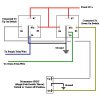Hi, this is my first post and I'm definitely an electronics novice. I've used relays in pre 1980's cars to greatly improve functions like power windows, locks, and headlights. That stuff is fairly straight forward. What I'm trying to do is make a 12v power lock system for my car that only uses a single momentary switch instead of a spdt switch. I've found a few schematics online that are similar but not exactly like what I'm trying to do using relays. I also found a few projects using a spdt relay to accomplish something similar. My big question is whether or not this is even worthwhile in terms of complexity and durability. I've never seen anything other than spdt switches for locks and windows in cars, so I'm thinking there's a reason for that. I was planning on using Bosch style automotive relays, but would an IC in a project box be any better in terms of durability?
Is this possible using a spdt realy to flip-flop the signal coming from the momentary switch? The signal would activate a spst relay to power the up function on the door lock actuator. A second push of the switch would flip the signal to activate a second spst relay to power the down function. Power door actuators have 2 terminals, one for up and one for down and then they ground to the cars chassis.
Please be gentle on an old noob, I haven't even seen a breadboard in over 25 years! lol
Is this possible using a spdt realy to flip-flop the signal coming from the momentary switch? The signal would activate a spst relay to power the up function on the door lock actuator. A second push of the switch would flip the signal to activate a second spst relay to power the down function. Power door actuators have 2 terminals, one for up and one for down and then they ground to the cars chassis.
Please be gentle on an old noob, I haven't even seen a breadboard in over 25 years! lol

